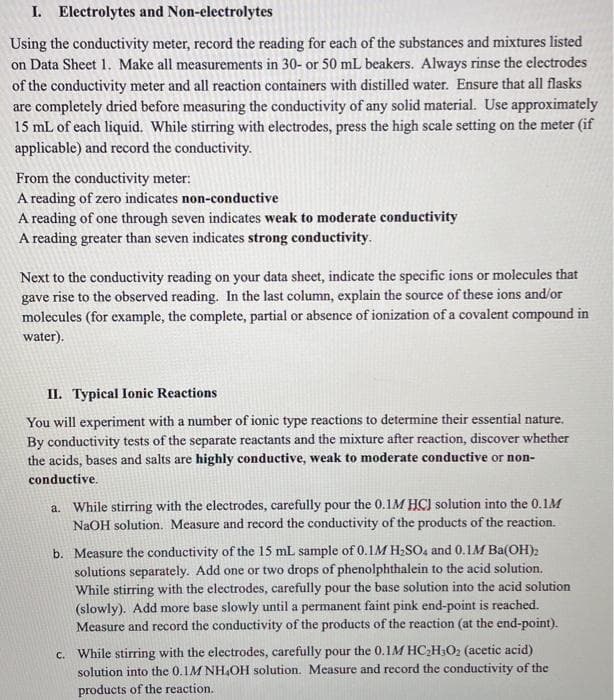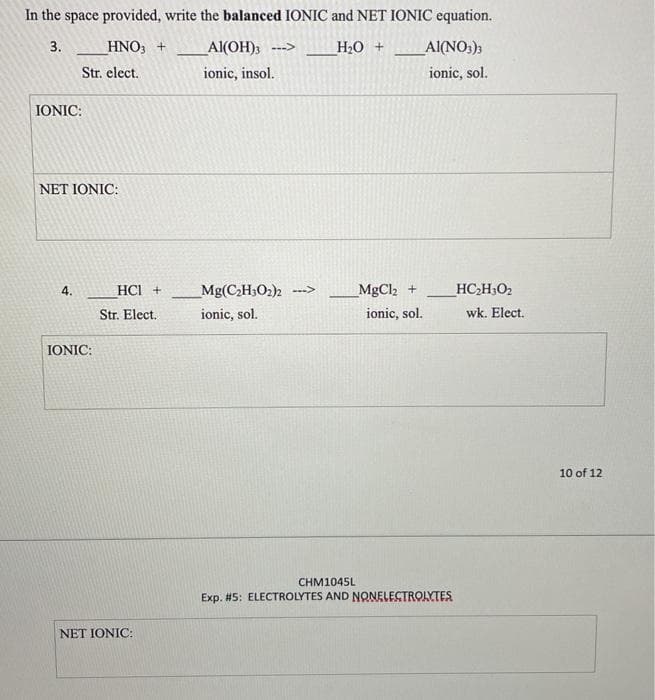In the space provided, write the balanced IONIC and NET IONIC equation. 3. HNO, + Al(OH), -> H2O + Al(NO,)) Str. elect. ionic, insol. ionic, sol. IONIC: NET IONIC: 4. HCI + _Mg(C2H,O2)2 _MgCl2 + HC,H,O2 Str. Elect. ionic, sol. ionic, sol. wk. Elect. IONIC: 10 of 12 CHM1045L Exp. #5: ELECTROLYTES AND NONELESTROIXTES NET IONIC:
In the space provided, write the balanced IONIC and NET IONIC equation. 3. HNO, + Al(OH), -> H2O + Al(NO,)) Str. elect. ionic, insol. ionic, sol. IONIC: NET IONIC: 4. HCI + _Mg(C2H,O2)2 _MgCl2 + HC,H,O2 Str. Elect. ionic, sol. ionic, sol. wk. Elect. IONIC: 10 of 12 CHM1045L Exp. #5: ELECTROLYTES AND NONELESTROIXTES NET IONIC:
Chapter4: Types Of Chemical Reactions And Solution Stoichiometry
Section: Chapter Questions
Problem 122CP: In the spectroscopic analysis of many substances, a series of standard solutions of known...
Related questions
Question
Plz do Asap...!

Transcribed Image Text:I. Electrolytes and Non-electrolytes
Using the conductivity meter, record the reading for each of the substances and mixtures listed
on Data Sheet 1. Make all measurements in 30- or 50 mL beakers. Always rinse the electrodes
of the conductivity meter and all reaction containers with distilled water. Ensure that all flasks
are completely dried before measuring the conductivity of any solid material. Use approximately
15 mL of each liquid. While stirring with electrodes, press the high scale setting on the meter (if
applicable) and record the conductivity.
From the conductivity meter:
A reading of zero indicates non-conductive
A reading of one through seven indicates weak to moderate conductivity
A reading greater than seven indicates strong conductivity.
Next to the conductivity reading on your data sheet, indicate the specific ions or molecules that
gave rise to the observed reading. In the last column, explain the source of these ions and/or
molecules (for example, the complete, partial or absence of ionization of a covalent compound in
water).
II. Typical Ionic Reactions
You will experiment with a number of ionic type reactions to determine their essential nature.
By conductivity tests of the separate reactants and the mixture after reaction, discover whether
the acids, bases and salts are highly conductive, weak to moderate conductive or non-
conductive.
a. While stirring with the electrodes, carefully pour the 0.1M HCI solution into the 0.1M
NaOH solution. Measure and record the conductivity of the products of the reaction.
b. Measure the conductivity of the 15 mL sample of 0.1M H2SO, and 0.1M Ba(OH)2
solutions separately. Add one or two drops of phenolphthalein to the acid solution.
While stirring with the electrodes, carefully pour the base solution into the acid solution
(slowly). Add more base slowly until a permanent faint pink end-point is reached.
Measure and record the conductivity of the products of the reaction (at the end-point).
c. While stirring with the electrodes, carefully pour the 0.1M HC2H3O2 (acetic acid)
solution into the 0.1M NH,OH solution. Measure and record the conductivity of the
products of the reaction.

Transcribed Image Text:In the space provided, write the balanced IONIC and NET IONIC equation.
3.
_HNO, +
Al(OH);
H20 +
Al(NO3);
Str. elect.
ionic, insol.
ionic, sol.
IONIC:
NET IONIC:
4.
HCI +
Mg(CH3O2)2 ->
MgCl2 +
HC,H;O2
Str. Elect.
ionic, sol.
ionic, sol.
wk. Elect.
IONIC:
10 of 12
CHM1045L
Exp. #5: ELECTROLYTES AND NONELESTROLYTES
NET IONIC:
Expert Solution
This question has been solved!
Explore an expertly crafted, step-by-step solution for a thorough understanding of key concepts.
This is a popular solution!
Trending now
This is a popular solution!
Step by step
Solved in 2 steps

Knowledge Booster
Learn more about
Need a deep-dive on the concept behind this application? Look no further. Learn more about this topic, chemistry and related others by exploring similar questions and additional content below.Recommended textbooks for you


Chemistry
Chemistry
ISBN:
9781305957404
Author:
Steven S. Zumdahl, Susan A. Zumdahl, Donald J. DeCoste
Publisher:
Cengage Learning

Chemistry: An Atoms First Approach
Chemistry
ISBN:
9781305079243
Author:
Steven S. Zumdahl, Susan A. Zumdahl
Publisher:
Cengage Learning


Chemistry
Chemistry
ISBN:
9781305957404
Author:
Steven S. Zumdahl, Susan A. Zumdahl, Donald J. DeCoste
Publisher:
Cengage Learning

Chemistry: An Atoms First Approach
Chemistry
ISBN:
9781305079243
Author:
Steven S. Zumdahl, Susan A. Zumdahl
Publisher:
Cengage Learning

Introductory Chemistry: A Foundation
Chemistry
ISBN:
9781337399425
Author:
Steven S. Zumdahl, Donald J. DeCoste
Publisher:
Cengage Learning


Chemistry: Principles and Practice
Chemistry
ISBN:
9780534420123
Author:
Daniel L. Reger, Scott R. Goode, David W. Ball, Edward Mercer
Publisher:
Cengage Learning